I’ve hiked into the Waipio Valley several times - most recently about 2 years ago. Ever since then I’ve wanted to return, yet again, to explore further and to really enjoy the beauty and serenity of this magnificent valley.
With a 4 and 3 year old on the trip with me this time, I thought it would be best to drive into the valley - which I had never done. All the guide books, maps, signs, and people will tell you a true 4-wheel drive vehicle is required… and they are right! Our 4×4 Ford Explorer would suffice, and thus we headed north from Hilo, up the Hamakua Coast to the Waipio Valley Lookout. During this trip to the Big Island, we found out the island was suffering from a big drought - consequently, the normally overcast skies here at the overlook were absolutely clear and blue. It looked as if a cold front had just blown through leaving no haze and the sunshine drenched the very green (and damp-looking) valley below.
After a short pit-stop at the Lookout, we stopped the vehicle at the top of the road - it is a 25% steep grade road, extremely narrow, winding, and overall intimidating. We shifted into neutral, engaged the 4-wheel drive, and began our descent! Even in the lowest gear (4-speed automatic) and in 4-wheel drive, we still had to basically ride the brakes otherwise preventing a “runaway train” scenario. As we navigated the steep road wide views of the valley below were right in front and below us. We passed numerous hikers en route to the bottom - some prepared well with packs, water, good hiking shoes… others were wearing flip flops or jeans and looked quite out of place (and also uncomfortable). The road is so narrow that opposite traffic can only pass you in certain spots that are barely wide enough to traverse - so keep your eyes on the road ahead and scan for vehicles way ahead of you - especially if you are ascending, because you don’t want to stop your truck on a steep incline for fear of sliding backwards when you let go of your brakes!
At the bottom of the valley, the road hits a T-intersection and we turned right (east) following the road parallel the valley and towards the black sand beach at its mouth. This road is unpaved, and normally engulfed in huge puddles and deep mud from all the rains and runoff down here. We navigated around the first seveal series of large puddles until we reached one that stretched across the entire road. We downloaded one passenger who helped us gage the depth of the puddle by simply trudging through the muddy water with sandals on (not the cleanest way to do it - but pretty effective); I’d recommend using a branch or walking stick instead.
After confirming our ground clearance, we pushed ahead, right through the middle of this gigantic puddle - and onto the next and the one after that… Eventually, we reached the coast. Here, the lush jungle canopy is left behind as we transitioned to an almost pine-forest area. Tall coniforous trees swayed gently in the breeze and the ground was a mix of dirt and black sand. We parked the truck under the trees and scrambles across a wide swath of black rocks and small boulders to finally reach the black sand beach!
The kids were enthralled by the ride down into the valley. The best part about it was the excellent views that they had - even from their vantage point in their car seats - they were able to see (due to the steepness of the grade) way down into the valley below.
The Waipio is glorious and its beauty is stunning. There are stark contrasts here with the vibrant green tropical rain forest behind us, the towering fertile cliffs bounding either side of the valley - stretching up to 2,500 - 3,000 feet in elevation and carved out by dozens of waterfalls, the jet-black sand of the beach, and the white froth of the ocean waves as it pounds the shore.
Amazingly, there were about a dozen other people down here, some playing on the beach, others swimming in the shallow water, and the bravest (and clearly locals) were riding the huge waves on their surfboards at the southern edge of the valley’s mouth. The scene was spectacular. They say the waters here are rough and unpredictable and that there are numerous dangerous rip currents and ocean hazards. We did not enter the water. Instead we explored the beach, walking north to the actual river itself that (in this time of drought) was not the giant force that it normally is - instead it was about 6-12 inches deep in its center, but still a steady current of water (fed by rain and the many Waipio waterfalls). The river carved its way through the center of the valley (much deeper and wider inland) finally exiting into the ocean at the black sand beach. Across the river and snaking its way steeply up the northern wall of the valley is the menacing switch-back trail leading you across seveal gulches and ultimately into the next deep valley - the Waimanu Valley.
The kids absolutely loved the black sand beach. It is pretty wide and very long - allowing plenty of room to run like the wind down the beach! The waves were pounding the shore with good force and the kids really enjoyed creeping up to the edge of the water’s reach as the waves reached up onto the beach - then running away as the next set of waves invaded. The kids also were fascinated with the river. As they stood on the black sand banks of the river, they could see the water moving over the black rocks below and twisting its way to the beach. Of course they found sticks (as kids always seem to do) to stick into the rapid waters and to carve letters and drawings onto the thick black sand.
After spending some time relishing the scene, we got back in the truck and drove inland. We followed this same dirt road riddled with puddles back (to the west) and continued on past the turn off to ascend out of the valley. We continued west as the road curved back and forth paralleling the river. We saw several paddle boarders working their way downstream in the middle of the river - standing tall on their boards while paddling. As we continued the road would turn and inbetween trees we would make out brief moments when we could view the exhilirating Hiilawe Falls (the top of which is about 1,600′ in elevation). This is the Waipio Valley’s most famous waterfall and is situated in the southwestern corner of the valley, framed by two large bulges in the valley wall on either side of it.
We continued up the road and eventually made a hard right turn (northbound) on this same road. We passed several very austere, very rural, and very primitive homes and farm plots (taro root is the main “legal” crop down here). Eventually, we could not continue without having to drive our vehicle across the actual river itself - although it did not look overly deep at this point, concerns of safety and lack of confidence in our rental vehicle caused us to turn around. There was a small group of hikers that had just crossed the river and were moving ahead into the more remote section of the valley. Part of me wanted to follow them - but not today; not with the young kids in our party.
We headed back the way we came and ultimately turned up and ascended the way we came down - that same narrow, vertigo-inducing road back up. We kept our momentum up - never stopping on any steep incline during the ascent - for fear that the truck would start sliding backwards if we were to let go of the brakes (on a steep hill). Our rental vehicle did not have downhill (or uphill) assist control or any of the niceties that other trucks have, so we just had to make do. We did pass several other (opposite direction) vehicles on the way up and had to time our passing so as to allow their passage and avoid us from sliding back down! We finaly reached the top, stopped the truck, shifted back into neutral, then disengaged the 4-wheel drive. Whew - what a journey!
We elected to continue driving up to the town of Waimea for lunch on our way to Kona. The 3-year old fell asleep on our drive to Waimea. The sun was amazingly still shining and we had great views of Mauna Kea.
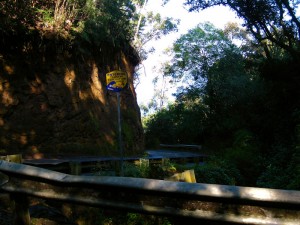
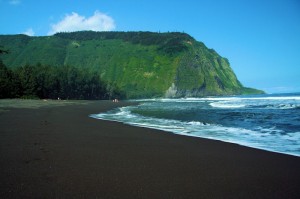




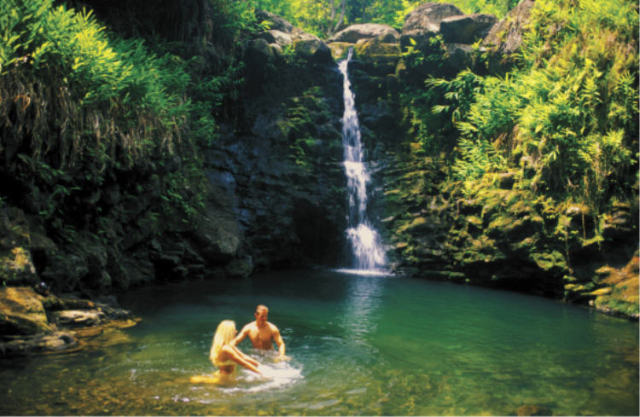 Hike
with an expert guide in Hawai'i Volcanoes National Park, in the rain
forests, deep in remote valleys, and explore hidden waterfalls
Hike
with an expert guide in Hawai'i Volcanoes National Park, in the rain
forests, deep in remote valleys, and explore hidden waterfalls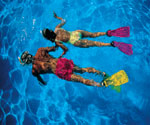
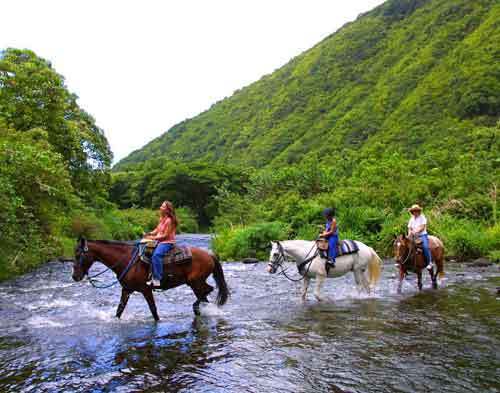 Enjoy
a picturesque Hawaiian horseback ride through the Valley of the
Kings, a lush tropical paradise of jungle trails, waterfalls, and spiritual sites.
Enjoy
a picturesque Hawaiian horseback ride through the Valley of the
Kings, a lush tropical paradise of jungle trails, waterfalls, and spiritual sites.
